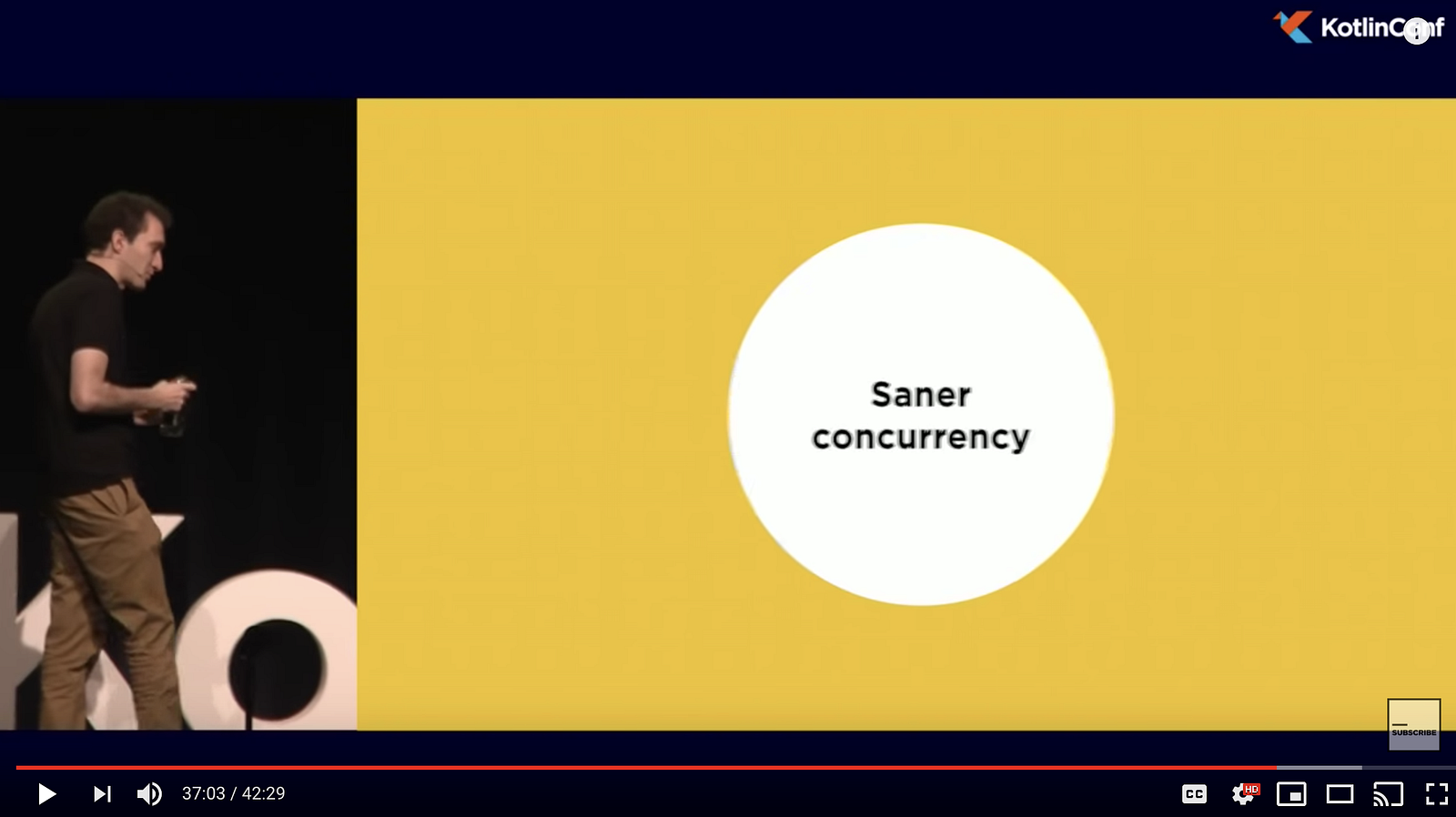· 5 min read Posted by Kevin Galligan
Saner Concurrency (and the cost of change)

I’ve been talking about Kotlin/Native for a little while now, and one of the big things I tell people is that threading will be very different than what they’re used to. It’s just something that you need to learn and understand.
Kotlinconf was a couple weeks ago. Progress on Multiplatform was definitely a big topic. A more general discussion surfaced around how Jetbrains and the Kotlin team are thinking about concurrency. Andrey said in his Keynote that future Kotlin will focus on Saner Concurrency. I think we should unpack this a bit.
It is generally accepted that managing concurrency by using mutexes, synchronized blocks, etc (AKA. “manually” or “status quo”), is difficult and error prone. Concurrency in Java, with Java’s concurrency primitives, is difficult.
Some languages attempt to improve upon this situation using various approaches. Another point from the keynote I thought was great is that being unique is not important. Assimilating the best ideas of other languages is important (2:40).
Saner Concurrency
Kotlin/Native has baked into it some ideas about concurrency that make managing it safer. Andrey alluded to the idea that Kotlin, across variants, will start attempting to tackle “Saner Concurrency”. This is good to watch (37:00) to get a sense of where Kotlin is going, which makes me hopeful that not only will the various incarnations of Kotlin share the same concurrency concepts, but that those concepts will start to emerge as first class parts of the language at compile time rather than strictly runtime (Rust-like?).
By “various incarnations” I mean Kotlin-JVM will hopefully start getting some of the “new stuff” Kotlin/Native is getting🚧.
One of the consequences of change is that things will be different. We’ll need to learn new ideas, build different libraries, and adopt different ways of coding. That inevitably means resistance and time.
I wound up on the closing panel of the conference (thanks Hadi!), and one of the questions I gave an answer to addresses this issue. It wasn’t actually a question so much as expressing concern that the different threading model will slow down adoption (at 18:00)
I jumped in because, frankly, I had the same concerns earlier on. A few months ago I drafted up a blog post talking about how such a departure will impact adoption and may ultimately derail the effort. Thankfully, like most of my blog posts, I never finished it, and I don’t think that way anymore.
Considering it was on stage, at the end of a conference, I think I expressed my thoughts OK, but let me expand a bit here.
At the beginning of my talk, I told everybody about how I got there. I’d spent a couple years working on an architectural framework based on J2objc called Doppl. In short, compatible Android structures, lots of familiar libraries, and a gradle tool. Replicating testable mobile architecture across Android and iOS, in a familiar and practical manner.
How practical? The day after Google announced room, I got Room working on iOS, from the java source jars, in about 90 minutes.
Here’s the thing, though. Nobody cared. I bet more people read this post in the first week than read that post after a year and a half.
Obviously these aren’t direct parallels. The Android community wants Kotlin and iOS wants Swift, so pitching a Java/Objc thing isn’t fun (trust me). Community interest is critical, no matter how practical your pitch may be.
However, I think it’s also important to have a vision. Kotlin wants to adopt better, safer concurrency practices. They’re making the language available on many platforms, including Webassembly, and making “tough love” choices for a better future platform.
I think building something practical but somewhat compromised will make it easier to learn, and definitely easier to develop the library ecosystem necessary to support what currently exists, but it’s also uninspiring. It does not encourage change.
In short, yes, I think “giving up” on change would make adoption quicker for an individual iOS developer, but I don’t think it would be appealing to the iOS developer community. Change and new ideas, although they will take more work, are appealing and inspiring, and will ultimately be the best bet at gaining adoption.
When somebody says, “Kotlin is just Swift for Android”, this is meaningful pushback. It’s not simply “another language”.
In any case, it doesn’t matter. They’re doing it ✈️
This post started as one post, but turned into a monster. Part 2 will be released after my Droidcon UK talk Friday where we announce a new Kotlin Multiplatform state management library…
🚧 I didn’t want to derail up top, but one major issue for right now is that JVM and Native do some runtime things fairly differently. That is likely to create confusion early on, especially with teams that have engineers fully on one platform or the other. It would be great if we could run JVM with the same runtime checking as Native, even if just in a debug configuration.
